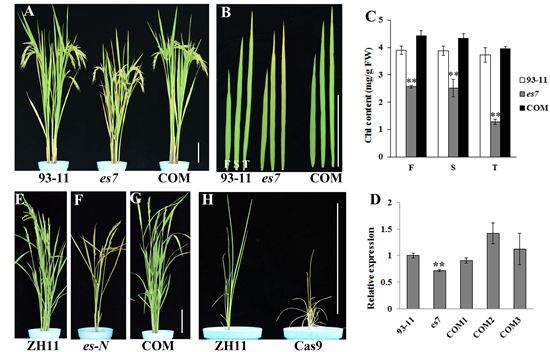分享到
ES7, Encoding a Ferredoxin-dependent Glutamate Synthase, Functions in Nitrogen Metabolism and Impacts Leaf Senescence in Rice
Nitrogen is a key macronutrient required by plants for growth and development, it is also important for the yield and productivity of crops. Rice plants grown in paddy fields use ammonium as the major source of inorganic nitrogen. It is established that the glutamine synthetase/glutamate synthase (GS/GOGAT) cycle is the only route for primary ammonium assimilation in plants grown under normal conditions.
Recently, researchers from China National Rice Research Institute (CNRRI), Chinese Academy of Agricultural Sciences successfully identified and characterized an early senescence 7 (es7) mutant. The result showed that the leaves of the es7 mutant begun to senesce at the tillering stage about 60 days after sowing, and became increasingly senescent as the plants developing at the heading stage. When es7 plants grew under photorespiration-suppressed conditions (high CO2), the senescence phenotype and chlorophyll content were rescued. qRT-PCR analysis showed that senescence-associated genes were up-regulated significantly in es7. A map-based cloning strategy was used to identify ES7, which encodes a ferredoxin-dependent glutamate synthase (Fd-GOGAT). ES7 was expressed constitutively, and the ES7 protein was localized in chloroplast. qRT-PCR analysis indicated that several genes related to nitrogen metabolism were differentially expressed in es7. Further, chlorophyll synthesis-associated genes were significantly down-regulated in es7. In addition, when seedlings grew under increasing nitrogen concentrations (NH4NO3) for 15 days, the contents of chlorophyll a, chlorophyll b and total chlorophyll became significantly lower in es7. This work demonstrated that ES7 is involved in nitrogen metabolism, affecting chlorophyll synthesis, and may also associated with photorespiration, impacting leaf senescence in rice.
This study was supported by the National Key Transform Program (2014ZX08001-002), Zhejiang Provincial Natural Science Foundation of China (Grant LY16C130005), the Agricultural Science and Technology Innovation Program of Chinese Academy of Agricultural Sciences (CAAS-ASTIP-2013-CNRRI), the National Natural Science Foundation of China (Grant No. 31501290). The research finding has been published in Plant Science online on March 14, 2017 (DOI:10.1016/j.plantsci.2017.03.003.). More details are available on the link bellow: http://www.sciencedirect.com/science/article/pii/S0168945216306549

Fig. Functional complementation and CRISPR/Cas9 knock-out of ES7.
A–C. Phenotypes of wild-type (93-11) and the es7 mutant and the complementation line (COM) at the heading stage (A), a close up view of the upper three leaves (B), andChl content (C).
D. The relative expression of ES7 in 93-11, es7 and complementation (COM) plants.
E-H. Phenotypes of Wild-type (ZH11) (E), ZH11 background mutant es7-N (F), the complementation (COM) line (G), and CRISPR/Cas9 knock-out in the ZH11 background (H).F, flag leaf; S, second upper leaf; T, third upper leaf. Scale bars = 20 cm. Data is expressed as the mean ±SD. *, P ≤ 0.05; **, P ≤ 0.01.
Recently, researchers from China National Rice Research Institute (CNRRI), Chinese Academy of Agricultural Sciences successfully identified and characterized an early senescence 7 (es7) mutant. The result showed that the leaves of the es7 mutant begun to senesce at the tillering stage about 60 days after sowing, and became increasingly senescent as the plants developing at the heading stage. When es7 plants grew under photorespiration-suppressed conditions (high CO2), the senescence phenotype and chlorophyll content were rescued. qRT-PCR analysis showed that senescence-associated genes were up-regulated significantly in es7. A map-based cloning strategy was used to identify ES7, which encodes a ferredoxin-dependent glutamate synthase (Fd-GOGAT). ES7 was expressed constitutively, and the ES7 protein was localized in chloroplast. qRT-PCR analysis indicated that several genes related to nitrogen metabolism were differentially expressed in es7. Further, chlorophyll synthesis-associated genes were significantly down-regulated in es7. In addition, when seedlings grew under increasing nitrogen concentrations (NH4NO3) for 15 days, the contents of chlorophyll a, chlorophyll b and total chlorophyll became significantly lower in es7. This work demonstrated that ES7 is involved in nitrogen metabolism, affecting chlorophyll synthesis, and may also associated with photorespiration, impacting leaf senescence in rice.
This study was supported by the National Key Transform Program (2014ZX08001-002), Zhejiang Provincial Natural Science Foundation of China (Grant LY16C130005), the Agricultural Science and Technology Innovation Program of Chinese Academy of Agricultural Sciences (CAAS-ASTIP-2013-CNRRI), the National Natural Science Foundation of China (Grant No. 31501290). The research finding has been published in Plant Science online on March 14, 2017 (DOI:10.1016/j.plantsci.2017.03.003.). More details are available on the link bellow: http://www.sciencedirect.com/science/article/pii/S0168945216306549
By Luo Ju
luojurice@126.com
luojurice@126.com

Fig. Functional complementation and CRISPR/Cas9 knock-out of ES7.
A–C. Phenotypes of wild-type (93-11) and the es7 mutant and the complementation line (COM) at the heading stage (A), a close up view of the upper three leaves (B), andChl content (C).
D. The relative expression of ES7 in 93-11, es7 and complementation (COM) plants.
E-H. Phenotypes of Wild-type (ZH11) (E), ZH11 background mutant es7-N (F), the complementation (COM) line (G), and CRISPR/Cas9 knock-out in the ZH11 background (H).F, flag leaf; S, second upper leaf; T, third upper leaf. Scale bars = 20 cm. Data is expressed as the mean ±SD. *, P ≤ 0.05; **, P ≤ 0.01.
Latest News
-
 Apr 18, 2024Opening Ceremony of the Training Workshop on Wheat Head Scab Resistance Breeding and Pest Control in Africa Held in CAAS
Apr 18, 2024Opening Ceremony of the Training Workshop on Wheat Head Scab Resistance Breeding and Pest Control in Africa Held in CAAS -
 Apr 03, 2024IPPCAAS Co-organized the Training Workshop on Management and Application of Biopesticides in Nepal
Apr 03, 2024IPPCAAS Co-organized the Training Workshop on Management and Application of Biopesticides in Nepal -
 Mar 28, 2024Delegation from the School of Agriculture and Food Science of University College Dublin, Ireland Visit to IAS, CAAS
Mar 28, 2024Delegation from the School of Agriculture and Food Science of University College Dublin, Ireland Visit to IAS, CAAS -
 Mar 25, 2024Director of World Food Prize Foundation visited GSCAAS
Mar 25, 2024Director of World Food Prize Foundation visited GSCAAS -
 Mar 20, 2024Institute of Crop Sciences (ICS) and Syngenta Group Global Seeds Advance Collaborative Research in the Seed Industry
Mar 20, 2024Institute of Crop Sciences (ICS) and Syngenta Group Global Seeds Advance Collaborative Research in the Seed Industry
